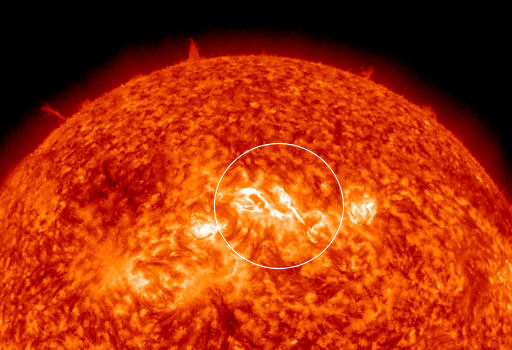
The CME captured by the Solar Dynamics and Heliospheric Observatory in February, 2013.
Coronal mass ejections are powerful, energetic events on the Sun which can also have serious repercussions for terrestrial life, see e.g.
http://brane-space.blogspot.com/2012/06/cme-that-you-dont-want-to-see.html
How do coronal mass ejections occur? This is believed to happen via a sudden, mass transient ejection probably via a high Mach number shock wave. It has also been found that collisionless shocks form ahead of CMEs when the latter’s velocity exceeds the Alfven velocity of the ambient plasma in the corona. Recall this Alfven velocity is given by:
VA = Ö
(Bo
/ mo r o)
L = n o
l3 D
lD,s =[kT s εo / 4p Z s2 n s e2 ]
½
Here: Z s = 1 so that:
l D,s =
[(1.38 x 10-23
(10 6 K) (8.85 x 10 -12
F/m) / (4p) (10 16/m3) e2 ]
½
l D,s =
1.9 x 10 - 4 m
L = 7.3 x
10 4
And N = 4p n o l3 D / 3
N = (4p)(7.3 x 10 4 ) / 3 » 3.1 x 10 5
Therefore: 1/N = 1/
(3.1 x 10 5 )
1/N = 3.2 x 10 - 6
1/N ® 0 , hence the plasma is “collisionless” so that
this meets the condition.
Then
we may use the collisionless Vlasov-Boltzmann equation for a plasma
description, e.g.:
v
¶ f x/ ¶ x - q(s)/m(s) [¶ j/ ¶ x · ¶ f s/ ¶ v] = 0
where
(f s) is any function of the constant of the motion.
This,
along with its collisional form, has been called “the most important equation
in plasma physics”.[1]
The associated Poisson equation is:
Ñ E = 4p
e (ò fe d3 V - òf i d3V) = 0
where
the e, i –subscripts denote electrons
and ions, respectively and f refers to the appropriate distribution for each.
B
m = (2M – 1) Bo
Or
in terms of the ratio of the magnetic fields:
M
= 2 [B m / Bo] + 1
To
reach an M= 80 value, say which might conceivably apply for coronal shocks, one would need:
[B m / Bo] » 39.5
I.e.
the ratio of the maximum magnetic field intensity to the equilibrium value is
at least 39.5.
DN/
N = DB/ Bo [1 - DB/ 2 B] - 1
We
already saw for the equilibrium collisionless corona:
N » 3.1 x 10 5
It is instructional here to determine the trigger
or break point for the transient, or CME. This should be reached when the
massive influx of dissipating particles is so great that:
DN/
N ® ¥
By
inspection we see that if DB = 2B :
¥ = 2B/ Bo [1 – 2B/ 2 B] - 1
To
achieve this one would most likely need a strong two-stream instability
requiring (cgs units):
M
> 1 + [8p N Te / B2 ] 1/3
This
elicits the necessary magnitude for B given our values. A typical soliton –like
plot will appear:

The
relevant equation for a soliton embodying a dissipative term to evolve into a
shock can be written:
(-
v o + c s + v) ¶ v
/ ¶x’ - m ¶ 2 v / ¶x2’ + a ¶ 3 v / ¶x3
Where the underlined term above is the
dissipative term. In a collisionless plasma such as the corona under
consideration, the dissipation can be attributed to Landau damping and this may
be the most common form to excite a shock associated with CMEs. For all such
collisionless shocks the dissipative length scale, L << l mfp , the mean free path.
The preceding equation can be derived using an analog to Newton’s 2nd
law of motion, viz.
a
v” = F(v) = a d2v/ dt2 = -dF / dv
Where: F
= (c s - v o) v 2 / 2 +
v3/
6
Is
the Sagdeev Potential.
(To be continued - with problems)
No comments:
Post a Comment